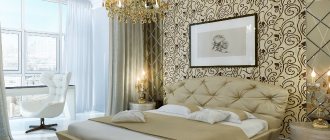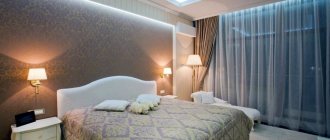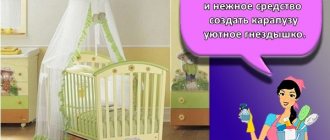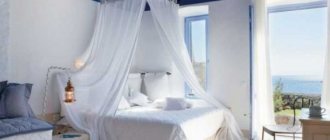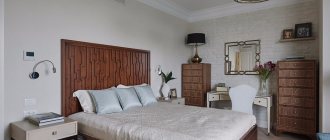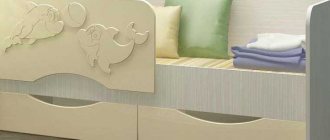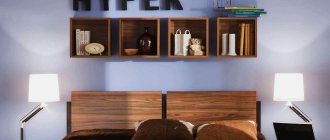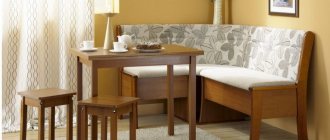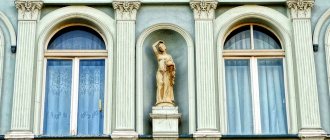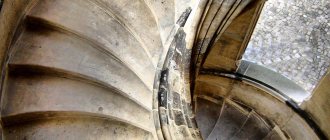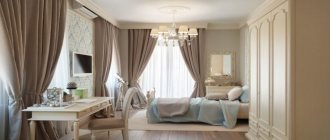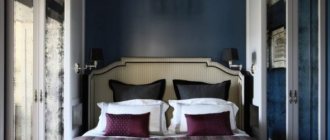The curtain over the bed is called a canopy, which is a piece of light fabric attached to the bed posts or hung on a cornice. The use of canopies goes back centuries, which is why it is associated with royal chambers. However, this detail has safely survived to this day. In the bedroom, where there is a bed with a weightless canopy, a gentle, calm and romantic atmosphere reigns.
What is the correct name for a canopy over a bed?
The first mentions of canopies are found in the East. They were made of natural silk, mounted on wooden frames, and protected from annoying insects and prying eyes. They later appeared in Europe - this was at a time when those who could afford to purchase large pieces of fabric lived in castles. It was cold there, the thick, heavy woolen canopy perfectly retained the heat.
Once upon a time, a canopy was necessary to protect the sleeper from insects and drafts.
Even later, canopies appeared in palaces. There they were luxurious, lace, trimmed with beads, pearls, hand-embroidered products, made from the most expensive materials. Forged or carved frames with the most bizarre shapes were created as support for them.
Street canopies
Canopy-cone for a balcony
Why not make a canopy on an open balcony? It will help protect against insects and create a special atmosphere of comfort. The easiest way is to make a canopy with a dome - just fix it on the balcony ceiling with a hook.
Photo: livethemma.ikea.se
Photo: livethemma.ikea.se
Canopy in the recreation area at the dacha
An outdoor seating area is the best solution for summer. To hide from the bright sun and insects, make a canopy.
If you have a bed on your open terrace, place 4 posts around it, connected by a frame, and hang light tulle over the bed.
Photo: livethemma.ikea.se
A canopy can be used to decorate sun loungers at the dacha. If they are on a deck or in the shade of trees, the canopy hook can be attached to the ceiling or branch. You can also stretch a rope between the trees and secure the canopy hook to it.
Photo: livethemma.ikea.se
Photo: livethemma.ikea.se
Photo: Instagram interior_delux
- Landscape
Making a swing-nest with your own hands: simple instructions in 5 steps
Advantages, disadvantages of canopy
Any canopy over a children's or adult bed has certain advantages:
- dense drapery protects from drafts, retaining heat;
- thin translucent fabric, when properly attached, protects against mosquitoes, flies, and midges;
- a dark blanket protects from sunlight and artificial light;
- an opaque option will create a closed personal space;
- a lace canopy will create a “zest” in the interior, making it luxurious and original;
- The product is easy to create with your own hands.
Currently, the canopy is more of a decorative than a utilitarian interior detail.
There are also some disadvantages:
- textile material collects dust, which is very dangerous for allergy sufferers;
- dense fabric does not allow air to pass through well, which is also not useful;
- the material often has to be washed in order for it to have a beautiful appearance;
- wrinkled fabrics require ironing after each wash, smoothing out all wrinkles and lace;
- clutters the bedroom, making it cramped.
Varieties of shapes, designs
Canopies over the bed differ not only in the type of fabric used, but also in the way they are hung. For various interior styles, luxurious, voluminous structures on high supports or more compact ones with unobtrusive fastenings are built. Different fabrics are also suitable: thick, warm ones are used to retain heat, mesh protects against insects, lace serves as decoration.
A stylish decoration made of frame and fabric creates a cozy atmosphere of privacy and tranquility.
Four-poster beds in the interior of rooms
If initially the functions of a bed with a canopy or canopy were to retain heat and provide sound insulation, now such systems are used most often for decorative purposes. The use of four-poster bed designs allows you to create a comfortable and very attractive atmosphere in the interior of the bedroom.
Types of frames
These are structures on four supports and semicircular “crowns”, ceiling beams and small rings, stretch ceiling cornices and wall fastenings. Also, drapery is sometimes located on the frame in the form of a rhombus, oval, wave, arc, or hoop. Using a canopy, the room is zoned.
On four supports
The four legs are usually an extension of the bed legs, pointing towards the ceiling. At the top, at a height of two to three meters or more, there are transverse crossbars through which the fabric is thrown. The design is suitable for classic, loft, and historical interiors. The most expensive options are decorated with forged and carved elements.
Increases comfort while sleeping by protecting against sunlight, drafts and mosquitoes.
Wall mount
Such holders have the shape of an arc, a semicircle, mounted to the wall in two places. The fabric is attached like curtains. For convenience, the fastening is made detachable - consisting of two flexible parts with a latch in the middle or on the edge. In another version, a long crossbar is attached to the wall, over which the fabric is thrown.
A canopy enlivens the bedroom interior, adding a touch of romance to the decor.
Canopy tent on a holder in the form of a ring
The round holder is suspended from the ceiling using a hook, attached to a tripod at the head of the bed, and mounted directly to the wall. In some options, in addition to the central fastening, tying is done on vertical posts located in the corners of the bed.
This decor helps set a certain style direction.
On the eaves of a suspended ceiling
The construction of such a structure is thought out in advance. In the suspended ceiling, niches are then provided for a hidden cornice - round, rectangular, oval. Less often, the cornice is made visible and very voluminous, but its installation will require preliminary installation of embedded bars.
The canopy creates an area of privacy and comfort, which is especially useful if the house has high ceilings.
On the headboard
There are also vertical fastenings mounted at the head of the bed, to its back. This canopy can be easily removed against the wall, and sometimes has additional wall holders.
Almost any bed can be decorated with a canopy.
Floor design
The structure is a heavy, stable tripod located at the head or side of the bed. In its upper part there is a split ring, an oval holder.
A canopy will not be superfluous over an elongated crib for an older baby, because the child still needs a comfortable sleep.
Suspended ceiling options
It is permissible to throw the drapery over a hollow pipe, a wooden crossbar located under the ceiling above the middle of the bed. Another suitable option is “sail”. Two crossbars are fastened with cables at four points, textile material is tied or put on them. The canopy appears to be purely symbolic, located only in a horizontal plane - nothing hangs to the sides.
To make the canopy look harmonious, the holder for it is selected taking into account the dimensions of the bedroom and bed.
What types of canopies are there?
Canopies can be sorted into several groups, which differ from each other in the method of fastening the structure. You can hang a bed canopy using:
Wooden and metal frame, based on four supports.
Here the racks are connected along the upper perimeter by slats on which the selected fabric is hung. This option is classic. Of course, this type of fastening is not suitable for small rooms, because the structure takes up a lot of space and “eats up” a lot of living space. But such a frame will support any weight of fabric, including heavy velvet.
How much fabric should you choose for this type of canopy? Designers recommend using material that is at least twice the length of the frame. For example, if this value is 4 meters, then more than 8 meters of material will be required. This amount of fabric can give the entire structure a more airy and elegant look.
A rod mounted into the wall, which is located vertically to the ceiling.
Here, at the head of the bed, at about a two-meter height, a metal rod is screwed into the wall. The latter must have stops at the free end so that the material does not slide off the smooth pipe onto the floor.
To select the right amount of fabric, measure the length from the bar to the floor. We multiply the resulting value in half. Do not forget that you need to add five cm to this figure for hemming the material itself. As a result, the width of the fabric we need will appear.
A decorative ring that is fixed to the ceiling or wall above the bed.
The bed canopy here is a kind of dome made of material. This design is fastened with a hook that is installed in the wall or on the ceiling above the bed. The fabric itself is hung on a special circle of small diameter using loops or eyelets. This hoop is secured with chains at the desired height. The latter are fixed on a built-in hook.
The canopy for a children's bed has a simpler and lighter design, which is made of durable wire. The fabric chosen is usually light and very little is needed, so heavy supporting elements are not needed here. Original fastenings are installed directly on the crib itself.
We calculate the required amount of fabric as follows. We measure the lower perimeter of the bed. We multiply the resulting value in half.
A cornice that is built into the ceiling.
The supporting structure here follows the contours of the bed or can be in the form of a headboard, for example in the shape of a semicircle. Very often, such supports are made in the form of a separate step in a multi-level ceiling. This design can also withstand heavy fabrics.
The amount of material is calculated in the same way as in the previous version. If the canopy will not cover the bed, but will serve a purely decorative function at the head, then we measure the perimeter of the latter. The resulting figure is doubled.
Frame materials
The frame base is made of metal, wood, in the case of small structures and light fabrics, for example plastic, hollow pipes. Sometimes the basis is cords and ropes stretched from the ceiling. In ethnic interiors, rough driftwood, sticks, and branches act as frames.
A large double design with a canopy is the most common option for a bedroom.
Canopy and room style
A canopy in a bedroom is a special, significant element of room design. Therefore, its presence requires a special approach to the choice of design, shape, and fabric. It is important to know and take into account the available area of the room, because in a small bedroom the presence of a canopy over the bed will make it even smaller. You should also take into account the lighting of the room and the style of its interior.
If we talk about the combination of a canopy with the style of the bedroom, then there are certain dependencies that make it possible to ensure the harmony of the interior design. For example, with a classic style you need to use heavy fabrics, but silk and satin fit perfectly into baroque.
In a bedroom decorated in high-tech style, the canopy should have a different look from the classic one (made of fabric). These can be any designs, but without fabric.
An oriental style canopy should look airy. The use of lightweight fabrics ensures this effect. By the way, a canopy without flounces and tassels will probably be a beautiful canopy, but not in an oriental style.
Canopy fabric
The textile materials used are very different, but it is advisable to use those that do not stretch or deform during use and washing. It is important to consider the length - it is advisable that the product goes down almost to the floor, as shorter options look “poor”.
When choosing fabric for a canopy, you need to take into account both the taste preferences of the bedroom owner and the style of the interior.
Nuances of choosing matter
Of course, a four-poster bed in an adult bedroom is somewhat reminiscent of a child’s bedroom - it is romantic and sophisticated. But the purpose of fabric draperies here is not practical and functional, but purely decorative. The purpose of a canopy is to create a romantic atmosphere, and only certain fabrics can do this.
Canopy for a crib
Traditionally, the bed is curtained with a veil or silk - translucent materials are perfectly suited to the intriguing atmosphere of the bedroom. Airiness, lightness, naturalness, a wide range of colors (so that you can create the desired textile combination) - all these are characteristics of popular canopy fabrics.
Canopy bed on the classic internet
However, heavy materials are also popular - for example, tapestry, jacquard and velvet. They are most in demand in classic “palace” styles, as they symbolize wealth and luxury. If velvet is a classic, then satin and silk are delightfully combined with carved gilded baroque furniture.
Canopy in a modern bedroom
And for a high-tech bedroom, there may be no fabric on the frame at all - just some hints of curtains. And this is in contrast to complex oriental draperies, where airy light fabrics are wrapped around the bed many times, creating multi-level mysterious canopies of the chambers of the Shamakhan queen.
A canopy in an oriental style is also necessarily complemented by flounces and tassels - these are its most recognizable decorations.
Note. The style of the bedroom and the style of the canopy should go together perfectly. The desired effect is provided not only by the texture of the fabric, but also by its color and pattern. Remember that the pattern and shades of the material for the canopy should be duplicated in other textiles - bedspreads, capes, curtains.
Use colorful and bright fabrics to create the atmosphere of an Indian harem. And in contrast to them - European restraint and elegant silk draperies in dark colors. White airy tulle will immediately remind you of a sunny, warm Mediterranean beach, and small flowers on the fabric will create a positive spring mood.
To create an atmosphere of restraint, use fabrics in cool colors, and for romanticism and sensuality, use impressive scarlet, delicate powdery or marshmallow pink, as well as deep precious shades of gold.
↑ back to contents
Design nuances for different types of furniture
Canopies are built over various pieces of furniture - single, single, double, bunk beds, sofa, house crib.
For a bunk bed
The canopy for a “two-story” structure, an attic, is usually attached to the sides of the upper tier. The drapery hides only the lower “floor”. Less common are canopies from the ceiling to the floor - then both the upper and lower bunks are covered with fabric.
Such canvases are distinguished by their tenderness, diffuse light well, but at the same time give a feeling of privacy.
For a double bed
For a double bed, a very voluminous canopy is made. Usually it is mounted on a frame that is integral with the bed. Options for a round or square ceiling cornice look good - the material seems to “flow” from the ceiling itself.
An elegant round bed with a transparent canopy looks especially gentle in the interior.
On a bed-house
A kind of “house” is obtained if you build a frame of the appropriate shape - when viewed from the end, it is pentagonal. Most often, the fabric is simply thrown over it or secured to the central crossbar. Less commonly, the upper part is sewn separately; four separate draperies are attached to its lower edge, tied with cords to the corner supports.
A canopy made of an airy veil will decorate the bedroom, but will not protect from sunlight.
The “tent” is different in that it is mounted on a round base located on top of the house. This is a solid frame, fixed to inclined posts leading to the corners of the bed, or the upper part is made suspended.
Above the sofa
The canopy, located above the sofa, is usually attached to the wall, along the long side of the folded structure. Ceiling options are used if the piece of furniture is folded forward. For modular sofas, which can be transformed in different ways, mobile mounts on folding ceiling hangers or narrow rails are suitable, where it is permissible not only to change the location of the canopy, but also the height relative to the floor level.
A well-chosen canopy decorates the bedroom and draws the eye to its central element.
Basic forms and designs of canopies
Light drapes of fabric or heavy velvet curtains are all canopies. The variety of versions is amazing. But three main directions can still be distinguished:
- fabric on the supports, helping to highlight the contour of the bed and emphasizing the space above it;
- suspended structures (including on consoles), where the main decorative role is assigned to the canopy;
- any textile compositions of any design, only “drawing” the desired spatial image.
Basic forms of canopies
If we talk about specific designs that are popular, we can note:
- Canopy on frame. The frame frames the space of the bed under the ceiling, and on the side there are necessarily racks made of wood and metal. The leading design elements can be either in the stand or in the canopy - if you do not want to decorate the bed with carvings or ornate wrought iron elements, then use expensive luxurious fabric.
- The canopy is a “crown” where the axis of the structure runs through the center of the bed. The frame in this case has the shape of a square or circle, and fabric is stretched through it. This is truly a royal decision that does not accept brevity in any form.
- Frame canopy - the fabric is attached to the frame in the form of an arc, and the arc, in turn, is carried to the headboard and attached to the wall. This type of canopy is considered attractive and functional, and most importantly, it is budget-friendly because it does not require complex supports.
- The basis of the canopy is a crossbar against the wall, and a piece of fabric is simply thrown over it. It looks casual and soft.
- If the design of the bed includes massive vertical posts , then they can be decorated with original fabric draperies - puffs, flounces, garlands.
- When the base of the bed is a completed design work, it is not hidden, but emphasized along the contour with flowing translucent fabric.
Canopy on a square frame
Canopy crown
Canopy on an arc
Crossbar for attaching canopy
Massive racks
Advice. Use translucent fabrics for a romantic atmosphere or floral patterns for natural chic - choosing fabric for a canopy is also a design art.
↑ back to contents
Features of a four-poster bed for different ages, genders
It is permissible to place curtains over the beds of people of any gender and age. Most often, this is done to ensure at least minimal privacy when several people sleep in the same room. The dark canopy allows you to relax and quickly fall asleep in a small cozy house.
Depending on age
Canopies of various designs will appeal to both adults, elderly people and children. Any fabric is acceptable, preferably one that does not collect a lot of dust. Under a canopy decorated in a palace style, it’s easy to feel like a noble person for a moment.
For an adult bed
The canopy over an adult bed is a “tent”, a quadrangular or round structure. This is a convenient thing for people who have difficulty relaxing and falling asleep. If desired, a lamp is mounted in the upper part of the structure to make it convenient to read before bed without disturbing others' sleep.
A bed with a canopy on the ceiling looks original and modern.
In the men's room, the canopy plays an exclusively functional role - protection from noise, light, and drafts. Any decorations are not appropriate here. The female version also performs protective functions, but is almost always also a decoration. It is sewn from shiny lace fabric, richly embroidered with colored threads.
Advice: in the case of creating a canopy for a couple’s bed, choose a neutral but luxurious option.
For a teenage bed
Canopies for boys and girls differ little from the designs of younger children of the corresponding sex, with the only difference being that young people already know exactly what they would like to see in their room. Many teenagers go through a period when they prefer dark colors - don't stop them from doing so. It is not necessary to sew a canopy from ordinary pure black fabric - it looks much more beautiful:
- anthracite gray;
- brown;
- fir-black;
- cobalt blue;
- dark red-brown;
- purple-black;
- grey-green;
- brown-willow;
- emerald black;
- sapphire blue;
- umber gray.
A canopy in a room helps create a special mood of relaxation after a hard day.
For the nursery
It is recommended to make the canopy over the bed of a toddler, preschooler, or elementary school student non-staining and from a material that can be easily washed. Small children often taste and touch everything, so the drapery gets dirty very quickly. The drapery forms part of the themed interior, where the baby will have fun playing.
The canopy has a decorative function, softly decorating the roofs of the houses.
For a newborn
The canopy over the baby’s crib creates a kind of dark, warm, cozy “nest” where the baby will feel protected. The canopy is usually placed over the cradle, made of two layers: a thin mesh layer will protect from mosquitoes, flies, midges, a denser one will protect from daylight, electric light, and drafts. The design ensures psychological peace and normal sleep for the baby.
A canopy is a very functional element of a crib for newborns.
Advice: the canopy must be secured firmly, as firmly as possible, preferably in several places, so that the child cannot tear it off or get too entangled.
History of appearance: the role of the canopy over the bed then and now
A four-poster bed is a classic sleeping place with a fabric canopy that can either completely cover the bed on top and sides, or be shortened.
The first canopies appeared in the ancient East, and they were used as protection from the heat: they were worn as an umbrella. At first, the use of such a design was available only to the king, and then to other influential persons.
Later, it began to be used as a canopy over beds to protect against drafts and blood-sucking insects. Rich people had custom-made canopies made of silk, velvet and satin, decorated with hand embroidery and precious stones.
By the way, in Europe the first canopies were made of stone, and their main purpose was to hide the sleeper from prying eyes. Then this expensive and heavy material was replaced by a more practical option - fabric.
In ancient Rus', canopies were known as canopies - canopies over a bed made of printed cotton.
Canopies have been used for more than one century, during which time they have undergone a lot of changes: from the types of fabrics used to the design and methods of fastening.
A modern canopy over a bed has several advantages:
- creates a favorable psychological atmosphere of comfort and security, hiding the sleeping person from prying eyes;
- canopies made of dense fabrics protect from daylight and have soundproofing properties;
- the design perfectly protects against annoying insects and allows you to sleep with the window completely open;
- in one-room apartments and studios, a canopy serves as an excellent way to separate the sleeping area from the working area;
- Using a canopy to create a sophisticated, romantic and cozy bedroom interior.
<
>
Canopies for an adult bed can be included with the bed or sold separately.
Depending on gender
Many parents decorate their children's rooms with beautiful canopies. Children of the same gender and age are often given the same canopies, different genders, but approximately the same age - different in color, but similar in design, so as not to disturb the overall room design.
For boy
The design in a boy's room often reminds of the sea and is made more austere than in a girl's room. Drapery is not decorated with lace, but ribbons and cords are acceptable. Suitable colors are sky blue, light gray, thistle, khaki, pistachio, moderate green, turquoise, snow blue.
Boys will like this design of a four-poster bed more.
For girl
The canopy over a girl's crib is usually replete with lace, frills, and is made in snow-white, lavender, apricot, soft pink, amaranth, lime, light yellow or fuchsia. Drapery is often associated with a doll's house or princess's palace, but more modest options are acceptable.
A girl over two years old will appreciate an original four-poster bed.
Neutral options
This design is suitable when two or more children of both sexes live in the bedroom. Excessive frill lace is inappropriate in this case; the colors are chosen to be the same for all canopies or overlap.
If there are no racks, then a frame placed under the ceiling can be used as a canopy.
Suitable options:
- ebony pink;
- light green;
- cornflower;
- beige;
- light yellow;
- pale coral;
- sand;
- pale purple;
- pale green;
- dandelion;
- pastel blue;
- olive;
- agate grey.
Types of canopy. Frame and mounting methods
Since the canopy today almost no longer plays its original protective function, it is more often used as a decoration for a sleeping place and room. Like any design element, it undergoes changes over time.
In some cases, his presence is barely noticeable, purely symbolic. As an option, this is a canopy consisting of only the upper part. This design will only protect you from plaster falling from the ceiling. But psychologists say that even such a symbolic canopy will give you a feeling of security and peace. This feeling is exactly what you need for normal, sound sleep.
There are several types of canopies. The most popular is the canopy hung on a frame. The frame is placed above the ceiling and secured to bed posts. Sometimes the frame is attached to the ceiling without forming a single unit with the racks - it looks great. This design is a transitional option from a rectangular to a tent-type design. But if your bed was not originally designed with a canopy, that is, there are no posts, then the option of simply attaching the frame to the ceiling is quite possible
Racks can be either wooden or metal. The design of this frame, of course, depends on your financial capabilities, since it can be made of valuable wood or forged metal, plus all sorts of artistic decorative elements.
For lovers of sophistication, there is a canopy in the form of a “crown”. In this version, the axis of the canopy passes through the center of the bed. The frame itself is made in the form of a circle or square, through which the fabric is threaded. The look, of course, of a bed with such a canopy is royal, but provided that the “crown” looks like a royal one, and not like a sports hoop with a cloth thrown over it.
The next beautiful canopy can be considered a fabric hung on a frame in the form of an arc. The arc is attached to the wall at the head of the bed. A very beautiful, functional and quite affordable canopy option.
A canopy, the curtain of which is thrown over a crossbar attached to the wall at the head, will be quite convenient and easy to make.
Modernity makes its own adjustments. Today, a canopy can be not only in the form of a fabric cape over the bed. It is often presented in rather original forms, only vaguely reminiscent of a classic canopy.
Agree that a canopy with elements of flora will create an incredible feeling of peace and relaxation in nature. And if you also hang a cage with a songbird, then... it will be a real piece of paradise.
How to make a simple canopy with your own hands
A simple way to make a beautiful canopy over a bed is available to anyone who has suitable fasteners, a little fabric, and imagination.
Advantages of creating a homemade version:
- interesting activity, new creative process;
- serious money savings - store buildings cost a lot;
- the opportunity to create a unique product;
- the sleeping place will be decorated in any chosen style; it is difficult to choose a canopy for it.
To work you will need:
- screwdriver;
- sewing machine, overlock;
- dowels, screws;
- threads, needles;
- scissors;
- suitable fabric - its quantity depends on the perimeter of the bed, length - at least two to three meters;
- cornice - a wooden stick or hollow pipe;
- decorative elements for decoration.
The picturesque canopy fits perfectly into the interior of a country-style room.
First, the canopy itself is sewn - from one or two fabrics, its edges are processed, decorated with tassels and frills. Loops and drawstring are sewn on top. The cornice is attached to the ceiling on vertical supports - first, fabric is strung on it and straightened.
The canopy material is chosen to be compatible with other room textiles - bedspreads, tablecloths, chair covers, floor mats. The product can be embroidered by hand or on a machine, decorated with beads, rhinestones, bows, flowers made of satin ribbons, paper butterflies on pins.
Types of canopies over the bed
Modern interior and furniture designers offer a lot of both classic and unusual options for canopies over the bed.
But from all the variety of designs, three main types of canopies can be distinguished:
- fabric attached to supports. Such a canopy allows you to highlight the contour of the bed, giving it a central place in the interior;
- hanging fabric. In this case, the canopy will play a major role in the decorative design of the bedroom;
- structures of non-standard design: a four-poster bed in the bedroom will perform the functions intended by the designer.
All canopies consist of two main parts:
- frame or hanger for fabric;
- fabric cloth.
Often, non-standard canopies are made to order, but modern furniture stores also offer ready-made options for unusual solutions for the bedroom.
Methods for attaching a canopy over a bed
Depending on the mounting method, the following types of bed canopies are distinguished:
- on the frame - the classic version;
- canopy - “crown”;
- "cords";
- framed.
A canopy bed on a frame allows you to create a luxurious interior: the space from the ceiling to the bed is framed by a frame, and on the sides there are wooden or metal stands with ornate and forged elements.
Fans of minimalism can hide the stands with fabric draperies - for example, garlands or flounces, or take a closer look at more modest canopy designs.
The “crown” design is used to create unusual designs: its axis is located in the center of the bed, and the frame has the shape of a circle or square through which the fabric is pulled. This option is considered the most sophisticated and aristocratic.
The “cords” design is used for interiors in loft style or any folk design. Special hooks are attached over the corners of the bed. Then slack cords are tied to them, on which the fabric is hung. The main advantage of this model is ease of installation.
In a frame canopy, the fabric is secured with an arc to the frame. This is the most budget option for attaching a canopy. The only drawback of this design is the need to attach the arc to the wall. In addition, such a canopy may be too modest to create a luxurious interior. But it will fit perfectly into the rustic or oriental style of the bedroom.
<
>
The classic design and frame canopy require quite a lot of free space, which makes it impossible to use them in very compact bedrooms or houses with low ceilings.
What fabric to choose for a canopy over a bed
If you want to choose a canopy for your bed and subsequently not regret your purchase, special attention should be paid to the fabric from which the canopy is made.
Of course, the main significance of a modern canopy lies in its purely decorative function, but some types of fabric can also have a practical purpose.
If you want to achieve a special, romantic atmosphere in the bedroom, then it is best to give preference to natural light, translucent fabrics - silk and veil. They will perfectly emphasize the tenderness and mystery of the interior. In addition, such light draperies will help visually expand the space - this is a godsend for cramped bedrooms.
Heavy, denser fabrics - velvet, jacquard and tapestry have long been a symbol of prosperity and luxury. Therefore, they are perfect for creating classic and palace interiors. In addition, such fabrics do not transmit light well, which is especially important for healthy sleep.
If your bedroom is designed in an oriental style, you can choose a canopy with tassels, and for a futuristic high-tech style, the fabric can be replaced with plain curtains.
The color of the fabric is also important. It can be either patterned or plain. It is desirable that the shades of the canopy be duplicated in other textiles in the bedroom - for example, curtains, bedspreads or bed linen. If you want to achieve the effect of restraint, then give preference to cold tones, and to create a cozy and sensual atmosphere, warmer ones - scarlet, orange, powdery and noble shades of gold.
Some people mistakenly believe that a four-poster bed in a bedroom is a dust collector and difficult to maintain. This is wrong. With regular cleaning, the canopy not only does not collect dust, but also protects the sleeping person from it.
